March 5, 2020 – Are you ready for spring’s explosion of green to overtake all the brown of winter? This is the first week of March, and after a mild Texas Gulf Coast winter, we’re starting to see early leaf buds and flowers. I loaded my gear in the car, and headed south to Brazos Bend State Park. This park not only borders on a curving stretch of the Brazos River itself, but it also contains extensive treed ponds and marshy areas. 40-Acre Lake in particular is a bird-watcher’s dream, with broad pathways at the edge of the water where you are close enough to watch birds in their natural habitat.
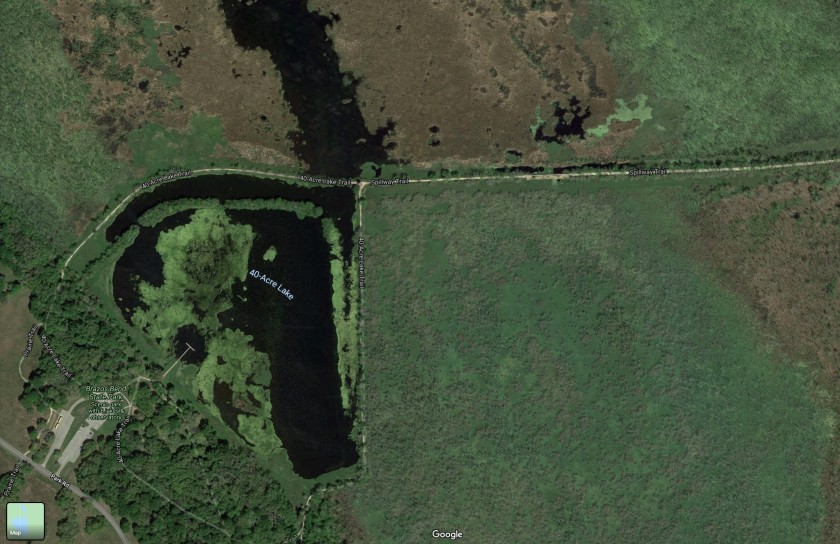
On this trip, I walked the northern portion of the 40-Acre Lake Trail, and the Spillway Trail. And, sure enough, there were alligators on, and alongside, the trail. Alligator eggs have hatched, and the babies are now 8 – 12 inches long. They rest on top of their mother; she is cold-blooded, but her body temperature fluctuates less rapidly than the lake water, so she helps insulate her young from the chilly spring weather. There is also her toothy smile, which helps discourage predatory herons and hawks.
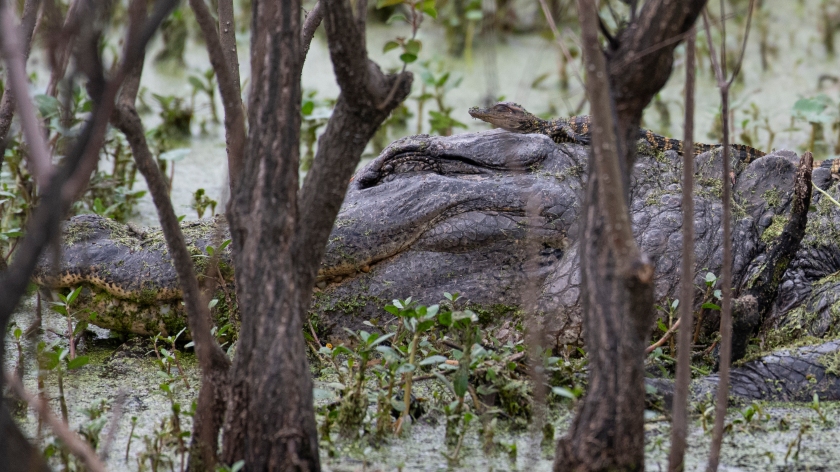
Nikon D850 with Nikkor 200-500mm f/5.6 ED VR
1/400 sec f/5.6 ISO 800 at 400 mm, on tripod
This was a new view of alligators for me. Both mother and baby are sleeping, their normally glittering reptilian eyes covered by pebbly eyelids. The mother is approximately 10 feet long, and as massive as a tree trunk. The hatchling is about 10 inches long, one of about 15 young grouped together lower on her back. They were roughly 50 feet away from me. I used a tight crop to focus on the texture of their armor and eyelids.
The trail at the northwest end of the lake is lined by trees, most still leafless from winter, but showing swelling buds. This Tufted Titmouse was singing away, flitting up and down the small branch, picking tiny insects from the bark. The Tufted Titmouse is here along the Texas Gulf Coast all year long… but it’s the first time I’ve seen and identified one (I told you at the beginning, I’m a novice birdwatcher). Because this was going to be a tight crop (he was tiny and about 20 feet over my head), I dropped my ISO, leaving myself with a slower shutter speed of 1/1000; I typically try to use a minimum of 1/2000 to stop action crisply… so I have dozens of photos of this little guy with blurred feathers.
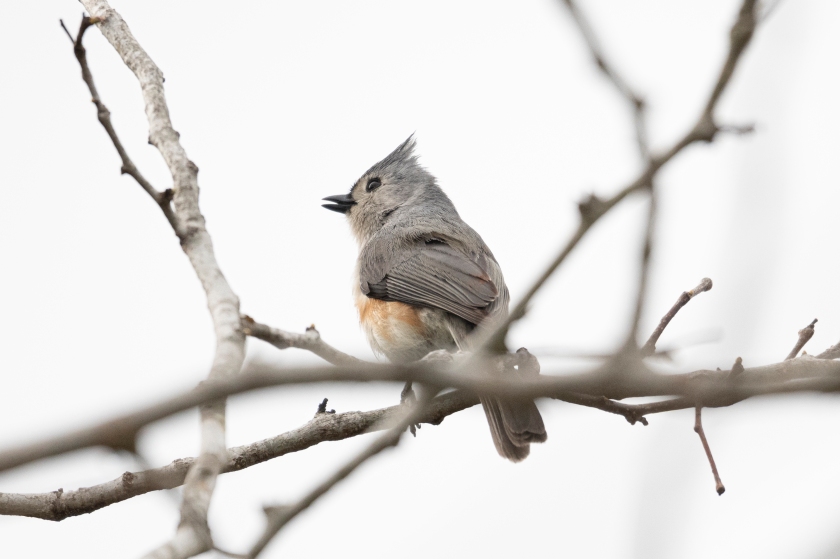
Nikon D850 with Nikkor 200-500mm f/5.6 ED VR
1/1000 sec f/5.6 ISO 800 at 400mm, on tripod
A little further down the path, I startled a handful of White Ibis feeding right beside the path. Drat. But when they flew into the trees across the lake, they startled another ibis, who flew straight back toward me and settled onto branches not 20 feet away! If I hadn’t given up when they flew away, I would have had a bird-in-flight photo to show you, but no. I have this lovely bird-on-a-stick photo instead. I got lucky – usually, their feet and bill are muddy from their hunting, but this one must have been foraging in the clear lake water.
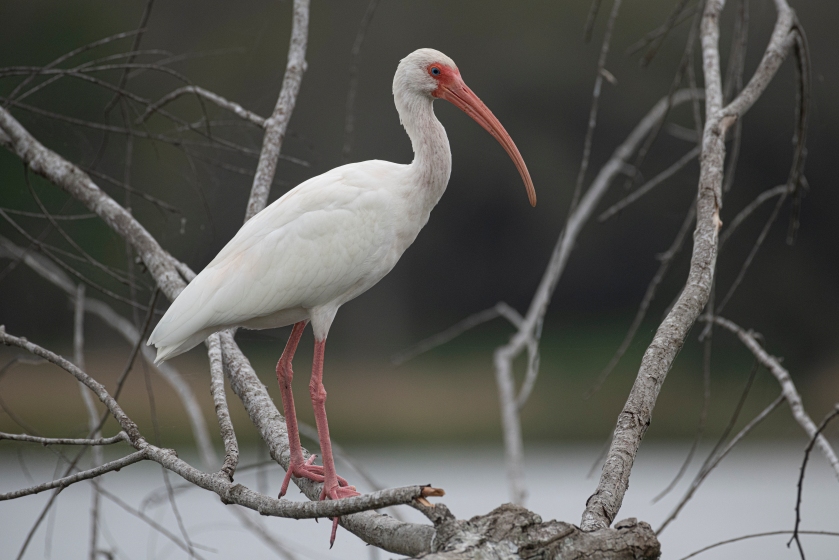
Nikon D850 with Nikkor 200-500mm f/5.6 ED VR
1/2000 sec f/6.3 ISO 800 at 500mm, on tripod
I have a new photo skill! I’ve learned how to move my camera’s auto-focus point around in the frame. My ibis images are almost full-frame (I cropped just a tiny bit around the edges to center him nicely, and to straighten the horizon), and his eye is in the upper half of each photo. I’m so glad my birds are no longer confined to the lower half of my viewfinder.
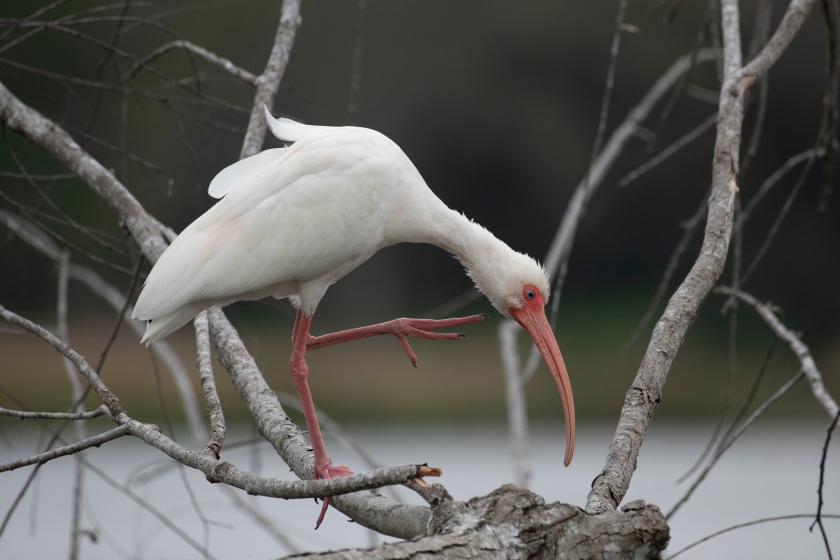
Nikon D850 with Nikkor 200-500mm f/5.6 ED VR
1/2000 sec f/6.3 ISO 800 at 500 mm, on tripod
I spent most of my afternoon with two male Anhingas near the intersection of 40-Acre Lake Trail and the Spillway Trail. These are unusual looking birds, 30 inches long and narrow, with a very interesting combination of feathers, both shiny and smooth, and fine and hairy. Though they are diving birds, spearing fish underwater, their feathers are not waterproof, soaking up water weight to help them submerge. After hunting, they perch on low open limbs over the water’s edge and spread their wings to dry, showing a characteristic silhouette among the trees.
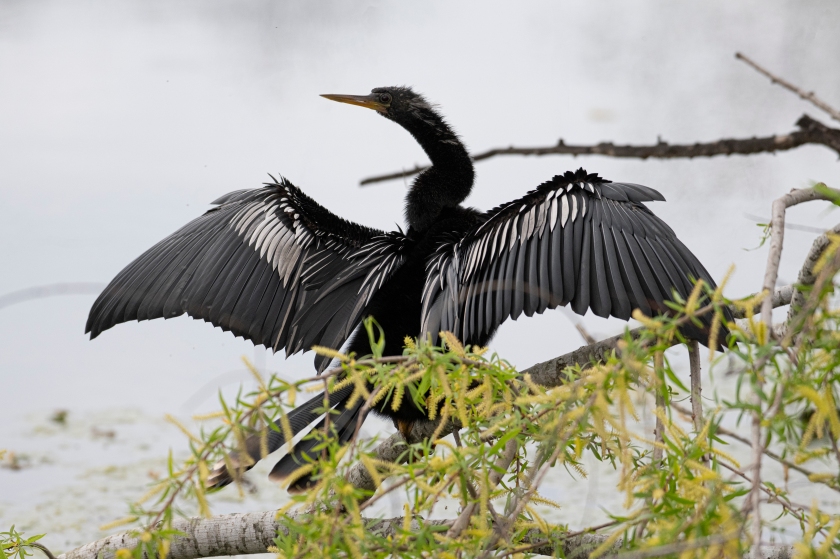
Nikon D850 with Nikkor 200-500mm f/5.6 ED VR
1/1600 sec f/5.6 ISO 800 at 500 mm, on tripod
The head, neck and shoulders of the male are almost all black, while those of the of juveniles and females are a soft fawn brown. This fellow has raised his mane, and is staring right at me. The mane of fine black feathers is interspersed with lighter brown as breeding season approaches. These are old feathers being discarded, but also make a convincing display (hat tip to SORA).
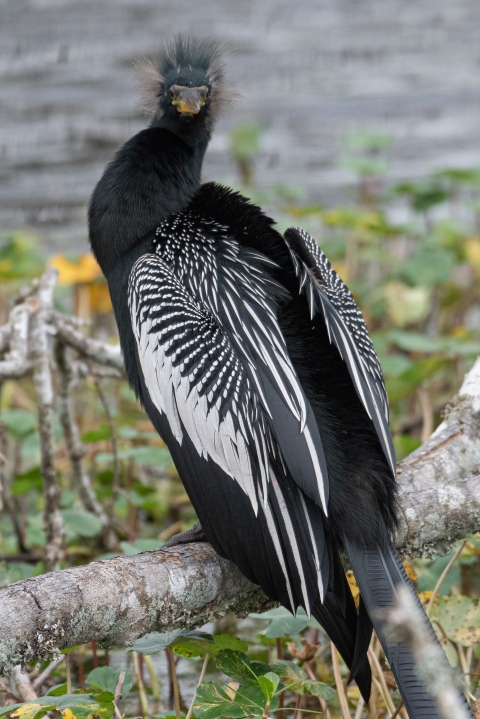
Nikon D850 with Nikkor 200-500mm f/5.6 ED VR
1/1600 sec f/5.6 ISO 800 at 330 mm, on tripod
The breeding plumage of the Anhingas consists of blue or blue-green lores (the skin around the eyes). And this bird appears to be transitioning from the dark brown on the bird in the upper photo, and the November photo below, to a yellow-green, part of the way toward his blue-green color. This is the same bird as “Who you lookin’ at”, but from the side, you can see the color of his lores more clearly.
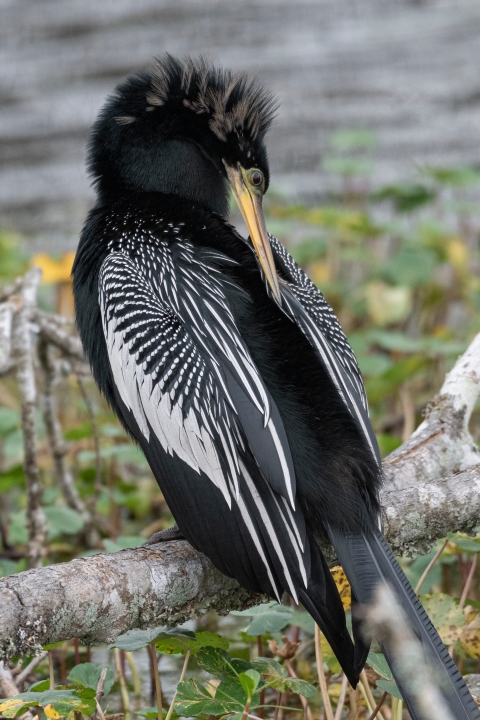
Nikon D850 with Nikkor 200-500mm f/5.6 ED VR
1/2500 sec f/5.6 ISO 800 at 390, on tripod
Just in case you’ve failed to appreciate the true beauty of this bird, here is a photo from November showing how his orange feet with their generous webbing echo his orange bill, and the ultra-fine feathers on his head catch the light. During the winter, the bird has no mane.
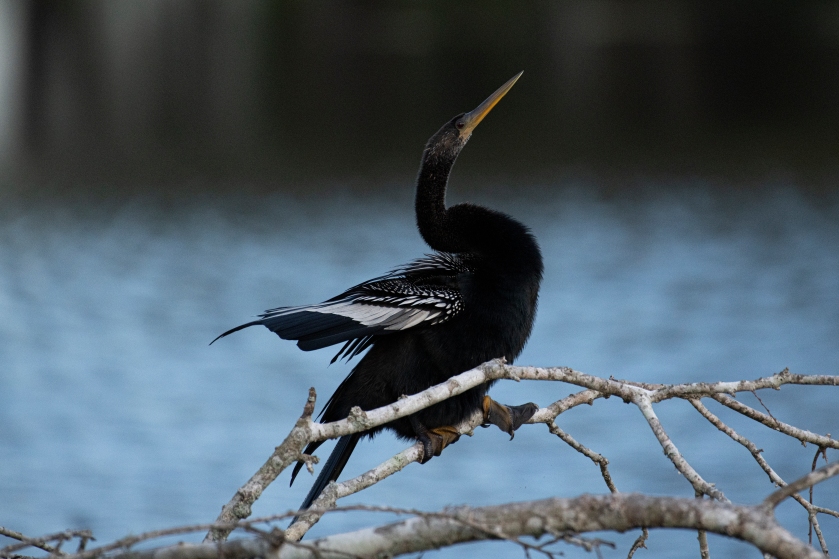
Nikon D850 with Nikkor 200-500mm f/5.6 ED VR
1/4000 sec f/5.6 ISO 1000 at 500mm, on tripod
As I left the park, I got one last true harbinger of spring – a male and female cardinal flitted into the tree above my head. They feasted on what I think are Red Elm flowers and seeds, but only the male was willing to be photographed. Yep, I’ll stoop to taking the belly-shot, I’m not proud!
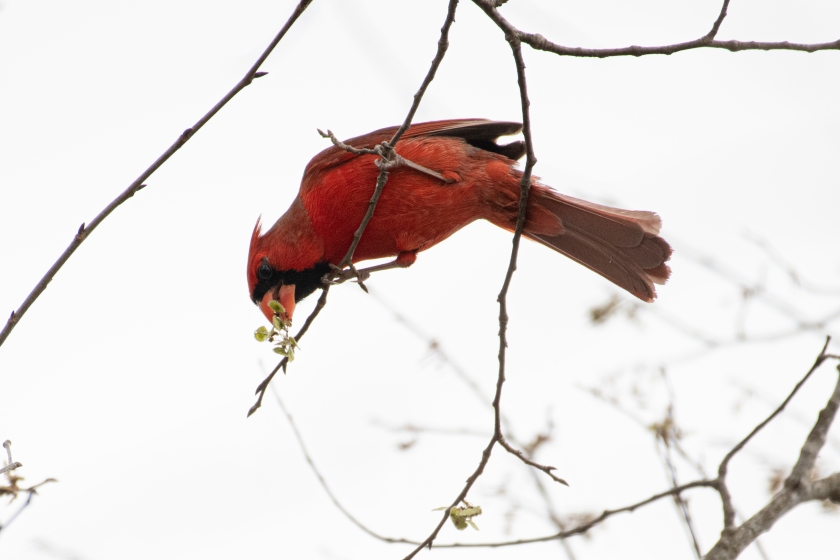
Nikon D850 with Nikkor 200-500mm f/5.6 ED VR
1/2000 sec f/5.6 ISO 1000 at 500, on tripod
The Park is about 35 miles from the coast, as the crow flies (I use Avian units of measure on this website). These birds and trees are definitely telling me that spring is underway, at least this short distance inland. I can’t wait!
Nice collection! Your White Ibis is getting his breeding colors, too. The bill and legs are starting to turn a bright red 🙂
LikeLike
I’m glad you pointed that out! I was thinking he looked even spiffier than a few months ago – bingo!
LikeLike
Love the Anhinga picks.
Bluebonnets are also sprouting – more along 10 than 290, and closer to San Antonio than Houston. I’m thinking next week’s the week.
LikeLike
You are so right, I’ve seen bluebonnets emerging in Houston, as well as along 36 half-way to Brenham. I think we might still have 2-3 weeks to the peak, but spring is definitely coming!
LikeLike